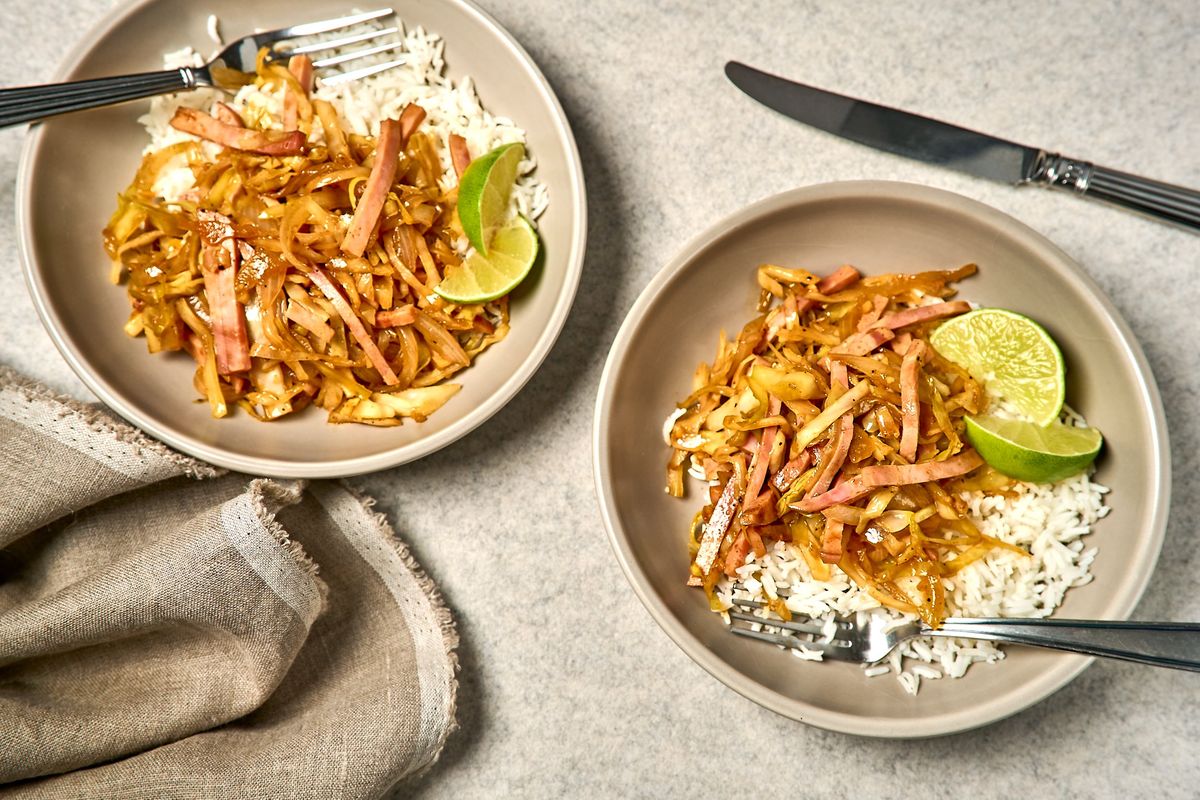Hoisin sauce gives new life to leftover ham in this cabbage stir-fry

Fresh off the heels of one holiday feast, now we’re going all out baking cookies and preparing to make another spread for Christmas dinner. For the cooks and home entertainers among us, the act of feeding our loved ones and celebrating the joys of the season can be tiring. So once you’ve baked up this year’s holiday ham and stored the leftovers in the fridge, keep things simple the next day with this quick and easy stir-fry for lunch or dinner. (Or breakfast – who am I to limit when this can be eaten?)
This recipe starts with thinly sliced cabbage and onion in a large skillet (or wok, if you have one) sprinkled with salt and pepper. Instead of the default black pepper, I suggest white pepper to switch things up a bit. The pale version of the spice possesses a softer heat and whiff of funk that I find enticing, but any color ground peppercorns you have in your pantry will suffice. Next, fresh ginger joins in on the fun to add another layer of spice and pungency.
The real star of the dish that ties it all together is hoisin sauce. Prominent in Cantonese cuisine, it is sweet and savory with a hint of tang. Recipes can vary, but common ingredients include fermented soybeans, some sort of sugar, garlic and various spices. If you’ve ever eaten char siu pork or Peking duck, then you’re already familiar with the flavor of hoisin. If not, then it’s worth seeking out.
In looking for a Western comparison, I’ve heard it referred to as Chinese barbecue sauce – probably due to the similarities in viscosity, sweetness and spice – but the American condiment lacks the savory depth of hoisin and is not an adequate substitute. Former Post food writer Candy Sagon deemed hoisin “one of the greatest cooking condiments ever invented and a pantry necessity.” It’s widely available in well-stocked grocery stores, and you can typically find it near the soy sauce. (Lee Kum Kee brand is generally regarded as the one to get.) And once opened, it should be good for at least a year or so in the fridge.
That is, if it lasts that long, given how many ways you can use it. Mix it into a marinade for tofu, meat or seafood. Similar to barbecue sauce, brush it on as a glaze for grilled or roasted proteins or as a sauce to coat chicken wings. Use it as a dipping sauce for dumplings. Dollop it on burgers alongside the rest of your favorite condiments. Drizzle it on a simple bowl of rice and vegetables for an easy boost of flavor.
Hoisin is as versatile as it is delicious, and this ham and cabbage stir-fry is just one way to familiarize yourself with the Chinese condiment.
Ham and Cabbage Stir-Fry
Hoisin sauce adds tons of flavor to this simple cabbage and ham stir-fry that’s an easy way to transform leftover meat from holiday feasts. Prominent in Cantonese cuisine, hoisin sauce is savory, sweet and slightly tangy. (Many store-bought brands contain wheat, so look for one without if you want this dish to be gluten-free.)
2 tablespoons neutral oil, such as canola or vegetable
½ small head green cabbage (1 pound total), quartered, cored and thinly sliced
1 small yellow onion (5 ounces), halved and thinly sliced
½ teaspoon fine salt, plus more to taste
½ teaspoon ground white pepper, plus more to taste
12 ounces cooked ham, preferably low-sodium, cut into strips (about 2½ cups)
One (1-inch) piece fresh ginger, peeled and minced or finely grated
¼ cup hoisin sauce
1 tablespoon fresh lime juice (from ½ lime), plus lime wedges for serving
Cooked white rice or other grain, for serving
In a large (12-inch) nonstick skillet or saute pan over medium-high heat, heat the oil until shimmering. Add the cabbage, onion, salt and pepper and cook, stirring occasionally, until starting to soften, about 5 minutes.
Add the ham and ginger and cook, stirring occasionally, until the vegetables are tender, about 5 minutes. Add the hoisin and lime juice, and cook, stirring frequently, until everything is evenly coated, about 1 minute; remove from the heat. Taste, and season with more salt and pepper as desired. Serve hot, in bowls, with rice and lime wedges.
Yield: Three to four servings
Storage note: Refrigerate for up to three days.
Substitutions: Green cabbage for any type of cabbage. Yellow onion for any type of onion. White pepper for black pepper. Lime juice for lemon juice, unseasoned rice vinegar or apple cider vinegar.